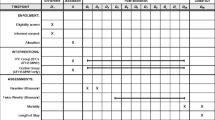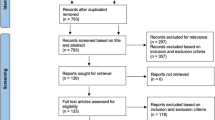Abstract
Purpose
Venous thromboembolism (VTE) is a frequent and serious problem in intensive care units (ICU). Anticoagulant treatments have demonstrated their efficacy in preventing VTE. However, when the bleeding risk is high, they are contraindicated, and mechanical devices are recommended. To date, mechanical prophylaxis has not been rigorously evaluated in any trials in ICU patients.
Methods
In this multicenter, open-label, randomized trial with blinded evaluation of endpoints, we randomly assigned 407 patients with a high risk of bleeding to receive intermittent pneumatic compression (IPC) associated with graduated compression stockings (GCS) or GCS alone for 6 days during their ICU stay. The primary endpoint was the occurrence of a VTE between days 1 and 6, including nonfatal symptomatic documented VTE, or death due to a pulmonary embolism, or asymptomatic deep vein thrombosis detected by ultrasonography systematically performed on day 6.
Results
The primary outcome was assessed in 363 patients (89.2 %). By day 6, the incidence of the primary outcome was 5.6 % (10 of 179 patients) in the IPC + GCS group and 9.2 % (17 of 184 patients) in the GCS group (relative risk 0.60; 95 % confidence interval 0.28–1.28; p = 0.19). Tolerance of IPC was poor in only 12 patients (6.0 %). No intergroup difference in mortality rate was observed.
Conclusions
With the limitation of a low statistical power, our results do not support the superiority of the combination of IPC + GCS compared to GCS alone to prevent VTE in ICU patients at high risk of bleeding.


Similar content being viewed by others
References
Attia J, Ray JG, Cook DJ, Douketis J, Ginsberg JS, Geerts WH (2001) Deep vein thrombosis and its prevention in critically ill adults. Arch Intern Med 161:1268–1279
Shorr AF, Williams MD (2009) Venous thromboembolism in critically ill patients. Observations from a randomized trial in sepsis. Thromb Haemost 101:139–144
Cook D, Crowther M, Meade M, Rabbat C, Griffith L, Schiff D, Geerts W, Guyatt G (2005) Deep venous thrombosis in medical-surgical critically ill patients: prevalence, incidence, and risk factors. Crit Care Med 33:1565–1571
Cook D, Douketis J, Meade M, Guyatt G, Zytaruk N, Granton J, Skrobik Y, Albert M, Fowler R, Hebert P, Pagliarello G, Friedrich J, Freitag A, Karachi T, Rabbat C, Heels-Ansdell D, Geerts W, Crowther M; Canadian Critical Care Trials Group (2008) Venous thromboembolism and bleeding in critically ill patients with severe renal insufficiency receiving dalteparin thromboprophylaxis: prevalence, incidence and risk factors. Crit Care 12:R32
Geerts WH, Heit JA, Clagett GP, Pineo GF, Colwell CW, Anderson FA Jr, Wheeler HB (2001) Prevention of venous thromboembolism. Chest 119:132S–175S
Hirsch DR, Ingenito EP, Goldhaber SZ (1995) Prevalence of deep venous thrombosis among patients in medical intensive care. JAMA 274:335–337
McKelvie PA (1994) Autopsy evidence of pulmonary thromboembolism. Med J Aust 160:127–128
Moser KM, Fedullo PF, LitteJohn JK, Crawford R (1994) Frequent asymptomatic pulmonary embolism in patients with deep venous thrombosis. JAMA 271:223–225
Stein PD, Henry JW (1995) Prevalence of acute pulmonary embolism among patients in a general hospital and at autopsy. Chest 108:978–981
Karwinski B, Svendsen E (1989) Comparison of clinical and postmortem diagnosis of pulmonary embolism. J Clin Pathol 42:135–139
Twigg SJ, McCrirrick A, Sanderson PM (2001) A comparison of post mortem findings with post hoc estimated clinical diagnoses of patients who die in a United Kingdom intensive care unit. Intensive Care Med 27:706–710
Blosser SA, Zimmerman HE, Stauffer JL (1998) Do autopsies of critically ill patients reveal important findings that were clinically undetected? Crit Care Med 26:1332–1336
Mort TC, Yeston NS (1999) The relationship of pre-mortem diagnoses and post-mortem findings in a surgical intensive care unit. Crit Care Med 27:299–303
Cade JF (1982) High risk of the critically ill for venous thromboembolism. Crit Care Med 10:448–450
Fraisse F, Holzapfel L, Couland JM, Simonneau G, Bedock B, Feissel M, Herbecq P, Pordes R, Poussel JF, Roux L (2000) Nadroparin in the prevention of deep vein thrombosis in acute decompensated COPD. Am J Respir Crit Care Med 161:1109–1114
PROTECT Investigators for the Canadian Critical Care Trials Group and the Australian and New Zealand Intensive Care Society Clinical Trials Group, Cook D, Meade M, Guyatt G, Walter S, Heels-Ansdell D, Warkentin TE, Zytaruk N, Crowther M, Geerts W, Cooper DJ, Vallance S, Qushmaq I, Rocha M, Berwanger O, Vlahakis NE (2011) Dalteparin versus unfractionated heparin in critically ill patients. N Engl J Med 364:1305–1314
Kahn SR, Lim W, Dunn AS, Cushman M, Dentali F, Akl EA, Cook DJ, Balekian AA, Klein RC, Le H, Schulman S, Murad MH; American College of Chest Physicians (2012) Prevention of VTE in nonsurgical patients: Antithrombotic Therapy and Prevention of Thrombosis, 9th ed: American College of Chest Physicians Evidence-Based Clinical Practice Guidelines. Chest 141(2 Suppl):e195S–e226S
Turpie AGG, Hirsh J, Gent M, Julian D, Johnson J (1989) Prevention of deep vein thrombosis in potential neurosurgical patients. A randomized trial comparing graduated compression stockings alone or graduated compression stockings plus intermittent pneumatic compression with control. Arch Intern Med 149:679–681
Lacut K, Bressollette L, Le Gal G, Etienne E, De Tinteniac A, Renault A, Rouhart F, Besson G, Garcia JF, Mottier D, Oger E, VICTORIAh (Venous Intermittent Compression and Thrombosis Occurrence Related to Intra-cerebral Acute hemorrhage) Investigators (2005) Prevention of venous thrombosis in patients with acute intra-cerebral hemorrhage. Neurology 65:865–869
Goodacre S, Sampson F, Thomas S, van Beek E, Sutton A (2005) Systematic review and meta-analysis of the diagnostic accuracy of ultrasonography for deep vein thrombosis. BMC Med Imaging 5:6
Limpus A, Chaboyer W, McDonald E, Thalib L (2006) Mechanical thromboprophylaxis in critically ill patients: a systematic review and meta-analysis. Am J Crit Care 15:402–410
Jacobs DG, Piotrowski JJ, Hoppensteadt DA, Salvator AE, Fareed J (1996) Hemodynamic and fibrinolytic consequences of intermittent pneumatic compression: preliminary results. J Trauma 40:710–716
Acknowledgments
This study was supported by a grant from the French Ministry of Health (PHRCN 2005 no. 08-13). COVIDIEN supplied the GCS (T.E.D.™ anti-embolism stockings) and the IPC (SCD EXPRESS™ compression systems with tubing sets and sleeves). The sponsor had no role in the study. We thank the research coordinator I. Pichon, the members of the CIC-P 0502 and the CIC-P 0801, the study nurses of the Clinical Research in Intensive Care and Sepsis Group (CRICS group), the Direction de la Recherche Clinique et Innovation (DRCI) of Brest University Hospital for their invaluable work, as well as Z. Alavi for her pertinent advice.
Conflicts of interest
The authors state that they have no conflict of interest.
Author information
Authors and Affiliations
Consortia
Corresponding author
Appendix
Appendix
CIREA1 collaborators:
Steering Committee: Pr Jean-Luc Diehl, Pr Philippe Vignon, Dr Anne Renault, Pr Karine Lacut
Adjudication Committee: Pr L. Bressollette (expert ultrasonographer), Pr Erwan L’Her
Data manager and Biostatistician: Elise Poulhazan, Emmanuel Nowak
Investigators:
Service de Réanimation Polyvalente, CH d’Angoulême, Saint-Michel: Dr Thierry Baudin-Jacquemin, Dr Sylvie Nicole Calvat, Dr Arnaud Desachy, Dr Florence Hospital
Service de Réanimation Médicale, CHU de la Cavale Blanche, Brest: Dr Montaine Lefèvre, Dr Jean-Marie Tonnelier, Dr Alexandre Tonnelier
Fédération d’Anesthésie, Réanimation Urgences, HIA Clermont-Tonnerre, Brest : Dr Christophe Giarcardi, Dr Bruno Ralec, Dr Mehdi Ould-Ahmed, Dr Didier Fourel, Dr Ba Vinh N Guyen, Dr Diane Commandeur.
Réanimation Polyvalente, CHU de Limoges, Limoges: Dr Jean-Bernard Amiel, Dr Marc Clavel, Dr Anthony Dugard, Dr Caroline Etchecopar-Chevreuil, Dr Bruno François, Dr Nicolas Pichon, Dr Jean-Claude Voultoury.
Service de Réanimation Médicale, CHU Hôtel Dieu, Nantes: Dr Olivier Zambon
Réanimation, CHR—Hôpital de la Source, Orléans: Dr Isabelle Runge, Dr Christian Fleury, Dr Marie Skarzynski, Dr Dalila Benzekri-Lefevre, Dr Anne Bretagnol, Dr Nicolas Bercault
Réanimation Médicale, HEGP, AP-HP Paris: Dr Emmanuel Guerot, Dr Ana Novara, Dr Christophe Faisy, Dr Iris Pelieu, Pr Nicolas Lerolle
Service de Réanimation Médicale, CHU de Poitiers, Poitiers: Pr Olivier Pourrat, Dr Julien Voultoury, Dr Michel Pinsard, Dr Anne Veinstein, Dr Jean-Pierre Frat, Dr Julie Badin, Pr René Robert
Service de Réanimation Médicale, CHU de Tours—Hôpital Bretonneau, Tours: Dr Annick Legras, Dr Emmanuelle Mercier, Dr Laure Batias-Moreau, Dr Stéphane Ehrmann, Dr Stéphanie Benardeau, Dr Maud Jonas, Dr Antoine Guillon, Dr Jennifer Buret, Dr Elodie Masseret
Vascular Ultrasonography Collaborators:
Imagerie Médicale, CH d’Angoulême, Saint-Michel: Dr Florence Hospital, Dr Danièle Colin, Dr Thierry Landois
Radiologie, HIA, Clermont-Tonnerre, Brest : Dr Jean Rousset, Dr Marc Garetier, Dr Diouf, Dr Sandra Chinellato, Dr Valentin Tissot
Unité Vasculaire du service de Chirurgie Thoracique et Cardiovasculaire, CHU de Limoges, Limoges: Pr Philippe Lacroix, Dr Tiphaine Bonnafy
Service d’explorations vasculaires, CHU Hôtel Dieu, Nantes: Dr Jérôme Connault
Angiologie, CHR—Hôpital de la Source, Orléans: Dr Carole Bazzi
Médecine vasculaire et hypertension artérielle, HEGP, AP-HP Paris: Pr Joseph Emmerich, Dr Emmanuel Messas
Radiologie, Echographie-Doppler, CHU de Poitiers, Poitiers: Dr Elisabeth Escure, Dr Cécile Thollot, Dr Jérôme Roumy
Pôle imagerie médicale, CHU de Tours—Hôpital Bretonneau, Tours: Dr Nicole Ferreira, Pr Frédéric Patat
Rights and permissions
About this article
Cite this article
Vignon, P., Dequin, PF., Renault, A. et al. Intermittent pneumatic compression to prevent venous thromboembolism in patients with high risk of bleeding hospitalized in intensive care units: the CIREA1 randomized trial. Intensive Care Med 39, 872–880 (2013). https://doi.org/10.1007/s00134-013-2814-2
Received:
Accepted:
Published:
Issue Date:
DOI: https://doi.org/10.1007/s00134-013-2814-2




